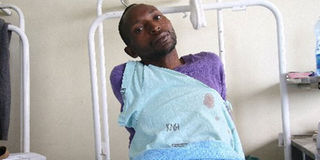Sunshine a luxury for those marking time in KNH ward

| Herman Meria Njuguna at ward 6A Kenyatta National Hospital during the interview on May 28, 2013. JENNIFER MUIRURI (NAIROBI) |
What you need to know:
- Men form the largest population of injured patients with five males to every female patient. This could be due to the nature of jobs men find themselves in — matatu drivers, conductors, or motorcyclists.
Stepping out to bask in the sun for most patients on this floor is wishful thinking.
For those who can, it’s a strenuous walk to catch the day’s sunshine.
They have been rendered immobile by traction while others are on crutches or have casts on their limbs.
Welcome to Kenyatta National Hospital’s sixth floor wards where patients with injuries are undergoing treatment. Majority of injuries are as a result of road accidents leading to broken upper and lower limbs as well as head injuries.
Three orthopaedic wards on this floor cater for adults while the fourth one caters for children.
Traction refers to the pulling on a bone or limb (as in a fracture) to relieve pressure or align parts in a special way during healing.
The weights used — typically five to seven pounds — are attached using tape, straps, or boots.
Men form the largest population of injured patients with five males to every female patient. This could be due to the nature of jobs men find themselves in — matatu drivers, conductors, or motorcyclists.
Most of the accidents have been blamed on riders with Dr James Mogire, an orthopaedic and trauma surgeon at the referral hospital, expressing concern over the rising number of accidents attributed to motorcyclists, most of whom are neither trained nor licensed.
“Three out of every 10 patients we see are from accidents caused by motorcycles,” he pointed out, adding that most county hospitals had a special ward for motorcycle accident victims.
On managing accident victims, Dr Mogire, also the KNH assistant director in charge of orthopaedic hospitals, called for the setting up of trauma centres countrywide to handle road accident injuries better.
“Well equipped trauma centres with qualified staff after every 200 km will be a great step in ensuring that injured persons are well managed thereby promoting faster healing because the patient got to a health facility in time,” he added.
Training on First Aid skills is also important to manage injured persons well before ambulance services arrive, he added.
“It’s also prudent to both train and retain doctors and other hospital staff to ensure health facilities are ready to deal with the high numbers of patients from road accidents,” Dr Mogire said referring to brain drain.
Health facilities, he noted, are ill equipped to treat broken limbs forcing patients to buy their own metallic implants which, he said, could cost between Sh50,000 and 100,000 depending on the severity and location of the injury.
Other than equipment, Dr Mogire said that it was important for the government to staff orthopaedic wings.
“Currently, there are 30 orthopaedic specialists in the country, 22 of whom are based in Nairobi, raising concerns on the shortage in the rest of the country,” he said adding the working conditions should be improved in the other parts in order to attract the bone specialists.
But the government is not the only focus as far as accidents are concerned. Dr Mogire blamed the ruthless attitude on Kenyan roads for causing most accidents.
“We express ourselves on the road by insulting or blocking other drivers instead of being courteous and observe traffic laws,” said the doctor in an interview with the Nation as he called for frequent inspection of vehicles and prosecution of offenders.




